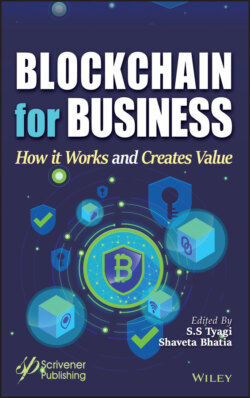Читать книгу Blockchain for Business - Группа авторов - Страница 13
1.1 Introduction
ОглавлениеSince the presentation of Bitcoin in 2009, its fundamental strategy, blockchain, has indicated promising application prospects and pulled in heaps of considerations from the scholarly community and industry [4]. Being the first digital money, Bitcoin was appraised as the top performing cash in 2015 and the best performing product in 2016, also, has more than 300K affirmed exchanges day by day in May, 2017. Simultaneously, the blockchain system has been applied to numerous fields, including medication, financial matters, Web of things, programming designing, etc. [4]. The presentation of Turing-complete programming dialects to empower clients to create brilliant agreements running on the blockchain marks the beginning of blockchain 2.0 time. With the decentralized accord component of blockchain, keen agreements permit commonly doubted clients to finish information trade or exchange without the need of any outsider confided in power [4]. Ethereum is presently (May of 2017) the most broadly utilized blockchain supporting keen agreements, where there are now 317,506 savvy contracts and in excess of 75,000 exchanges happened day by day [4].
Security comes on the top priority or the at most concern for any piece of action that is needed to be done or auctioned, hence the blockchain comes in a role play (Figure 1.1). Blockchain was basically developed by a group of researchers in the year 1991 to impart or emboss a time stamp on the digital documents but that didn’t work well and the experiment was the failure, due to which today’s psychedelic technology was garbaged [2]. In the year 2004 a computer scientist named Hal Finuey again reintroduced the blockchain with an alteration which was RPOW (Reusable Proof of Work).
A blockchain is a collection of four major components which collectively forms a block [2]. A blockchain is a decentralized, distributed, public ledger. It (blockchain) is a place to keep the record (transactional) which is decentralized as it can be created anywhere, whereas it is accessible anywhere, hence it is distributed, but what about the security aspect? as it can be accessed and created by anywhere and by anyone, which means there is a need to make the concept more feasible and secure.
Figure 1.1 Demonstrating the pictorial impression of blockchain [2].
When it is about privacy and security of any element/product/or a system, then it should have the basic working and the architectural knowledge of it. So, that the level of the security which are already existing can be updated or replaced for the better future [2].
In reference to the second chapter of this book, it explains to us about the working of the Blockchain. In this section of this chapter the basic architecture of the blockchain will be discussed, but moving ahead towards the architecture one should discuss few of the important terms which will be majorly used in the security and privacy aspects of the blockchain.
1 Immutable—Making the ledge secures with the digital signature or hash function.
2 POW—Proof of work, which is a protocol which has the main goal to deterring the cyber attacks.
3 Hash—It is unique value being assigned by the set of rules/algorithms/functions or the combination of all to make the ledger unique and separated from other blocks.
4 Digital Signature—It is another means of securing measure of the ledge, so that the data must be verified and treated as authentic.
5 Mining—Mining in general an activity to collect the useful out of whole.
These are the major terms which we may encounter in this chapter commonly. You will get to know more about these terms in the coming sections of this chapter, but before that the different types of blockchain architectures will be discussed below.
Logically, a blockchain is a chain of blocks which contain specific information (database), but in a secure and genuine way that is grouped together in a network (peer-to-peer) as shown in Figure 1.2. In other words, blockchain is a combination of computers linked to each other instead of a central server, meaning that the whole network is decentralized (Figure 1.3) [3].
Understanding it with the help of a relevant example like work on the Google docs and wait for others to make the necessary changes if required the same scenario is in the decentralized architecture of the blockchain. Blockchain allows and permit us to make the relevant docs shared rather copied [2, 3]. This distributed piece of information (ledger) provides the trust factor and the security of data.
Figure 1.2 The diagrammatic representation of the types of blockchain architecture [3].
Figure 1.3 Figure states the types of blockchains in trend.
Whereas the exact different case is there in the centralized architecture, the information or ledger which was shared is now kept private and shared with the authentic and with those who have required and necessary authority to access the data, which means now the data/ledger is kept private and not shared globally.
Now what left the distributed architecture, in this type a local copy of the ledger is given to all the parties/entities, so that the major alterations are done by the high officials or the major party whereas the information of the ledger is being distributed within the complete locality.
Table 1.1 will make the concept more clear and transparent to understand.
Table 1.1 A novel comparison among public, consortium, private blockchain.
| Property | Public blockchain | Consortium blockchain | Private blockchain |
| Consensus determination | All miners | Selected set of nodes | Within one organization |
| Read permission | Public | Public or restricted | Public or restricted |
| Immutability level | Almost impossible to tamper | Could be tampered | Could be tampered |
| Efficiency (use of resources) | Low | High | High |
| Centralization | No | Partial | Yes |
| Consensus process | Permission less | Needs permission | Needs permission |
